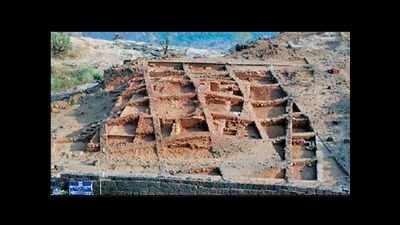Trending
This story is from May 18, 2018
Burning of Raigad Fort may be a myth: Experts

A number of rooms and a huge veranda around the structure have been uncovered at the site.
PUNE: A recent excavation at the Raigad Fort by the Archaeological Survey of India (ASI) and city-based Deccan College has left experts wondering if the fort and its structures were indeed burned during the Maratha-British War in 1818.
Archaeologists undertaking the excavation have dug up a huge structure buried two feet underground from one of the sites here. The structure and objects found showed no signs of charring, although it is believed to have existed right opposite the hill from where the British were positioned.
A number of rooms and a huge veranda around the structure have been uncovered and archaeologists believe these belonged to an important person in those times.The burning of the fort could have thus been a myth and folklore, they said.
Vice-chancellor of Deccan College Vasant Shinde told TOI that the excavation is the first of its kind being undertaken in the state under the initiative of Sambhaji Raje, a descendant of Chhatrapati Shivaji Maharaj. “The aim of the exercise is to identify the function of each locality and structure unearthed. Being Shivaji’s capital, we also expect to find a residential area, and other structures associated with art and craft,” he said.
The 50x50 meter structure also had several Maratha artefacts. “It seems to be from the time when the fort was fully utilized — around 1650 approximately. This structure was unearthed from the spot right opposite the hill from where the British had fired at the fort. Hence, burned remains should have been found at the site. However, there was no evidence of any such remains or debris,” said Shinde.
He further surmised that after the 1818 war, most people were compelled to leave the fort; so the structure must have disintegrated due to disuse. “The wood used for construction may have decomposed, while the wind activity and erosion aided in finally burying it. It does not, therefore, seem to have been destroyed suddenly,” he explained.
Shinde said that findings from the site will ultimately be preserved, while the activity can be extended to other forts across the state.
Archaeologists undertaking the excavation have dug up a huge structure buried two feet underground from one of the sites here. The structure and objects found showed no signs of charring, although it is believed to have existed right opposite the hill from where the British were positioned.
A number of rooms and a huge veranda around the structure have been uncovered and archaeologists believe these belonged to an important person in those times.The burning of the fort could have thus been a myth and folklore, they said.
Vice-chancellor of Deccan College Vasant Shinde told TOI that the excavation is the first of its kind being undertaken in the state under the initiative of Sambhaji Raje, a descendant of Chhatrapati Shivaji Maharaj. “The aim of the exercise is to identify the function of each locality and structure unearthed. Being Shivaji’s capital, we also expect to find a residential area, and other structures associated with art and craft,” he said.
Shinde said that written records state that Raigad fort was burned to ashes by the British, however the excavation found no such evidence. “There are more than 300 locations, where remains of habitations and structures could be buried. A recent excavation, close to the entry of the fort, unearthed a rectangular structure with a number of rooms and a verandah,” he said.
The 50x50 meter structure also had several Maratha artefacts. “It seems to be from the time when the fort was fully utilized — around 1650 approximately. This structure was unearthed from the spot right opposite the hill from where the British had fired at the fort. Hence, burned remains should have been found at the site. However, there was no evidence of any such remains or debris,” said Shinde.
He further surmised that after the 1818 war, most people were compelled to leave the fort; so the structure must have disintegrated due to disuse. “The wood used for construction may have decomposed, while the wind activity and erosion aided in finally burying it. It does not, therefore, seem to have been destroyed suddenly,” he explained.
Shinde said that findings from the site will ultimately be preserved, while the activity can be extended to other forts across the state.
End of Article
FOLLOW US ON SOCIAL MEDIA











